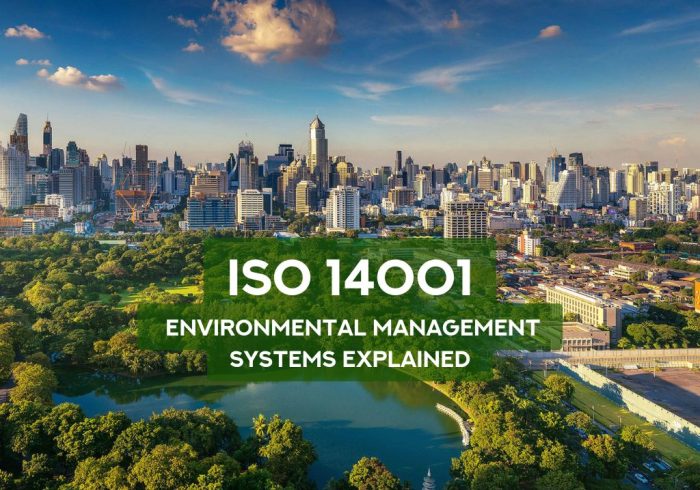ISO 14001
Environmental Management Systems Explained
ISO 14001 is one of the most well-known standards pertaining to the establishment, implementation, maintenance, and continual improvement of environmental management systems (EMS). The certification was initially established in 1996 by the International Organization for Standardization (ISO) and has been updated since.

Purpose and Scope of ISO 14001
The purpose of ISO 14001 is to provide an organization with the framework to protect the environment and respond to changing conditions in balance with socio-economic needs by setting intended outcomes for the company. This might include improving performance through monitoring key metrics, taking steps to ensure compliance obligations and optimizing processes to reach environmental objectives.
Key characteristics of ISO 14001 Certification
- Voluntary: The standard is voluntary and auditable which allows organizations to receive certifications of EMS.
- Applicability: Any organization – regardless of size, type, industry, sector or location – can be applicable for ISO 14001.
- Focus: ISO 14001 does not mandate specific environmental performance criteria or the levels of improvement to be achieved. Rather, it is focused on the framework an organization can follow for improvement.
In practice – ISO 14001, EMS and the PDCA cycle
The framework for an EMS under ISO 14001 is founded on the concept of the Plan-Do-Check-Act (PDCA) continual improvement cycle. This cycle provides a process for achieving continual improvement and is integral to all other ISO management systems.
The overall EMS specified by ISO 14001 involves defining policies and objectives and establishing processes to achieve those objectives. Specifically, an EMS aims to manage environmental aspects, fulfil compliance obligations, and address risks and opportunities.
The five main stages of an EMS defined by the ISO 14001 standard are:
- Commitment and Policy: Top management commits to environmental improvement and establishes the environmental policy, which serves as the foundation of the EMS.
- Planning
- Identify Impact items – The organization identifies environmental aspects of its operations (items that can negatively impact the environment, like air pollutants or hazardous waste).
- Set specific objectives – It determines which aspects are significant (biodiversity, waste reduction, emissions, water use, etc.) and sets objectives and quantified targets (e.g., reducing use of a chemical by 25% by a certain date).
- Implementation (Do)
- Carry out plan – The organization executes the action plan using resources, training employees and contractors, maintaining documentation, and setting up communication channels.
- Evaluation (Check)
- Monitor & Measure – The company monitors operations to evaluate if objectives and targets are being met, taking appropriate action if they are not.
- Review (Act)
- Ensure Effectiveness – Top management reviews the evaluation results to check the EMS effectiveness, determine if the policy aligns with organizational values, and revises the plan to optimize the EMS. This review stage facilitates continuous improvement.
Benefits of Implementing ISO 14001
Organizations adopting an EMS based on ISO 14001 typically experience several benefits:
- Environmental Improvement and Risk Mitigation: The system aids in reducing environmental impact and protecting the environment, including preventing pollution. It helps organizations mitigate potential adverse effects of environmental conditions on the organization.
- Compliance: It assists the organization in the fulfilment of compliance obligations (legal and other requirements), thereby minimizing the risks of breaches of legislation and potential fines or sanctions.
- Financial and Operational Efficiency: Benefits often include cost savings through more efficient use of resources (like water and energy), reduced waste, and enhanced operational control.
- Reputation and Competitiveness: Certification signals a commitment to sustainability, which can increase stakeholder and customer trust and enhance the organization’s market position. Certification is increasingly a requirement when bidding for work with larger corporations or the public sector.
The standard also requires consideration of a life cycle perspective meaning organizations must control or influence the impact of products and services from cradle to grave. This means that the way they are designed, manufactured, distributed, consumed, and disposed must be evaluated to prevent environmental impacts from being unintentionally shifted elsewhere within the life cycle.
ISO 14001 Relation to Other Standards and Recent Updates
ISO 14001 is designed to be compatible with other management system standards making it easier for organizations to integrate their EMS with many other systems, such as ISO 9001 (Quality Management) and ISO 50001 (Energy Management Systems.
The standard is currently undergoing a revision (ISO 14001:2025), which is expected to be published in the second half of 2025. The revision aims to enhance compatibility further by transitioning from the original High-Level Structure (HLS) to the new Harmonized Structure, and will include a stronger focus on climate action, risk management, and the integration of digital tools.
ISO 14001 is a powerful tool to enact real change within an organization. By establishing goals, outlining steps to achieve them and ensuring the success of your actions – organizations can benefit from a cycle of continuous improvement. If this is something your company is interested in, at Carbon Complete we provide consulting services to help you on your EMS journey. Contact us today for more information!
